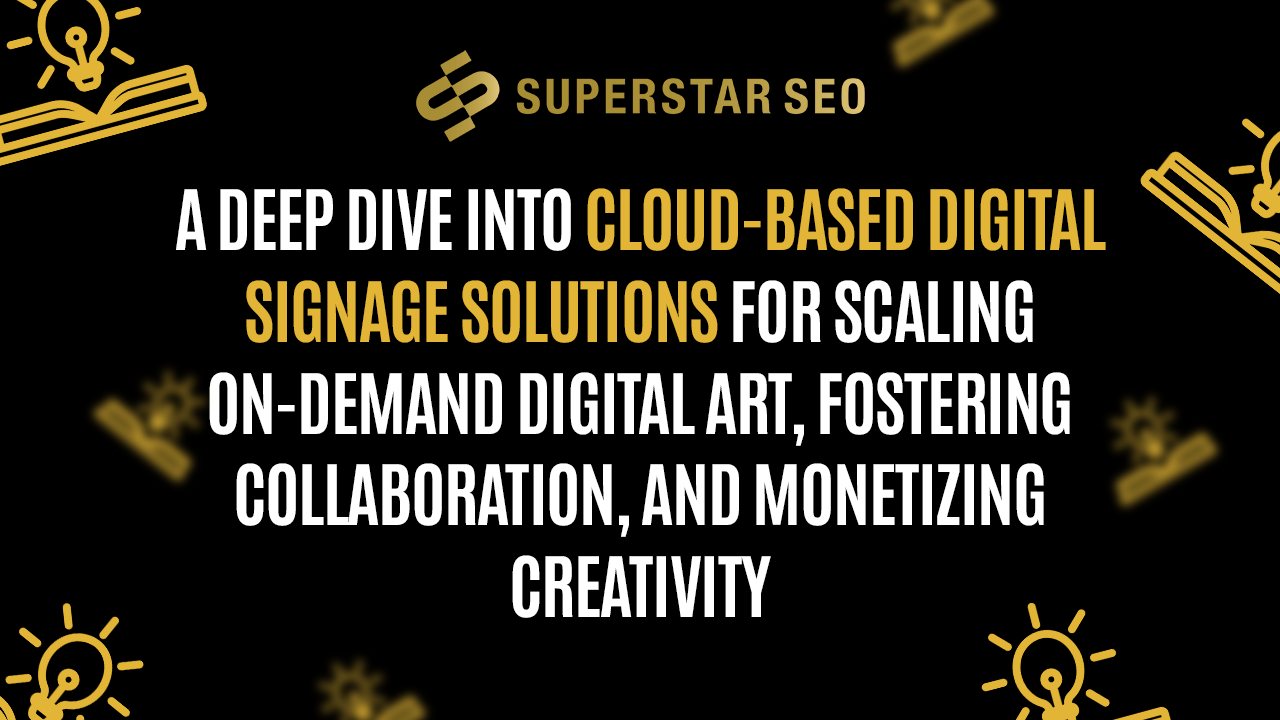A Deep Dive into Cloud-Based Digital Signage Solutions for Scaling On-Demand Digital Art, Fostering Collaboration, and Monetizing Creativity
Digital billboards have become a prominent choice for businesses seeking to capture attention in a visually compelling way. To harness the full potential of these digital billboards, selecting the right Cloud-based Digital Signage software is crucial. Here are key features to consider when evaluating such software for digital billboards.
Digital billboards operate in real-time, demanding software that can seamlessly handle dynamic content updates. An effective Cloud-based Digital Signage solution should offer robust content scheduling capabilities, allowing businesses to plan and automate the digital displays of content based on specific times, events, or promotions. This ensures that digital billboards stay relevant and engaging to the target audience.
Scalability is another vital aspect to consider. As the demand for digital billboard space grows, the software should effortlessly scale to accommodate an increasing number of displays. Cloud-based solutions, by nature, offer scalability advantages, enabling businesses to expand their digital signage network without the need for extensive hardware upgrades.
Remote management capabilities are a game-changer for businesses with multiple screens of digital billboards across different locations. The ability to monitor and control displays remotely through a centralized platform enhances efficiency and reduces the need for on-site interventions. Look for software that provides a user-friendly interface for remote management, allowing users to update content, troubleshoot issues, and gather insights from a single dashboard.
Interactivity is increasingly becoming a sought-after feature in digital billboards. Cloud-based Digital Signage software should support interactive elements, enabling businesses to create immersive and engaging experiences for their audience. Whether through touchscreens or mobile integration, interactivity opens up new possibilities for user engagement and data collection.
Security is a paramount concern, especially when dealing with public-facing digital displays. Moreover, most digital signage software should have robust security measures in place, including data encryption, user authentication, and secure communication protocols. This ensures that sensitive information displayed on digital billboards remains protected from unauthorized access or tampering.
The success of digital billboards relies heavily on the capabilities of the Cloud-based Digital Signage software powering them. By prioritizing features such as content scheduling, playlists, video walls, scalability, remote management, interactivity, and security, businesses can make informed decisions to enhance the effectiveness of their digital billboard advertising strategies. Choosing the right software is not just an investment in technology but a strategic move to stay ahead in the competitive world of digital signage.

Enhancing Efficiency: Cloud-Based Digital Signage Software for Digital Menus
Digital menus have become a game-changer, offering flexibility and engaging visuals for restaurants, cafes, and bars. The choice of Cloud-based Digital Signage software plays a crucial role in maximizing the efficiency of digital menus. Here are key considerations for businesses looking to leverage digital signage for their menus.
One of the primary features to look for in Cloud-based Digital Signage software for digital menus is dynamic content management. Restaurants often need to update their menus to reflect changes in offerings, prices, or promotions. The software should allow for easy content updates, enabling businesses to make real-time adjustments across multiple digital menu boards, ensuring accuracy and consistency.
Integration with Point-of-Sale (POS) systems is another essential factor. Seamless communication between the digital signage software and the POS system streamlines the ordering process. Changes in the POS system, such as new menu items or price adjustments, should automatically reflect on the digital menu boards, eliminating discrepancies and enhancing operational efficiency.
Customization capabilities are vital for creating a unique brand identity. Cloud-based Digital Signage software should offer templates and design options that allow businesses to tailor their digital menus to match their branding. This not only enhances the visual appeal but also reinforces brand consistency across various touchpoints.
Scalability is a consideration, especially for growing restaurant chains. As businesses expand, the digital signage solution should effortlessly scale to accommodate additional locations and displays. Cloud-based solutions excel in this aspect, providing the flexibility to manage a network of digital menus efficiently.
Remote management is a boon for businesses with multiple outlets. Cloud-based Digital Signage software should offer a centralized dashboard for remote monitoring and control. Managers should be able to update menus, schedule promotions, and monitor the performance of digital menus from a single interface, saving time and resources.
Interactivity can enhance the customer experience. Consider software that supports interactive features such as touchscreens for ordering, nutritional information displays, or QR code integration for mobile interactions. These features not only engage customers but also provide valuable insights into customer preferences and behaviors.
Cloud-based Digital Signage software can significantly enhance the efficiency of digital menus for restaurants and cafes. By prioritizing dynamic content management, POS integration, customization, scalability, remote management, and interactivity, businesses can create an engaging and streamlined dining experience for their customers. The digital menu becomes not just a list of items but a dynamic tool that contributes to operational efficiency and customer satisfaction.
Security Measures for Cloud-Based Digital Signage Deployments in Kiosks
Kiosks equipped with Cloud-based Digital Signage software have become integral in various public spaces, offering information, services, and interactive experiences. However, with the increasing reliance on digital kiosks, security becomes a paramount concern. Here are key security measures to consider when deploying Cloud-based Digital Signage in kiosks.
Data encryption is the first line of defense against unauthorized access and tampering. The Cloud-based Digital Signage software should employ robust encryption protocols to secure communication between the kiosk and the central server. This ensures that sensitive information displayed on the kiosk remains confidential and protected from potential cyber threats.
User authentication is crucial for restricting access to authorized personnel. Implementing strong authentication mechanisms, such as multi-factor authentication, ensures that only authorized users can make changes to the content or settings of the kiosk. This helps prevent unauthorized individuals from tampering with the information displayed or causing disruptions.
Secure communication protocols play a vital role in protecting data during transmission. The Cloud-based Digital Signage software should utilize secure and encrypted channels for sending and receiving data between the kiosk and the cloud server. This mitigates the risk of data interception and ensures the integrity of the content displayed on the kiosk.
Regular software updates are essential for addressing vulnerabilities and improving overall security. The chosen Cloud-based Digital Signage solution should have a robust update mechanism that allows for timely deployment of security patches and feature enhancements. This proactive approach helps in maintaining a secure and resilient kiosk network.
Physical security measures are often overlooked but are equally important. Kiosks should be physically secure to prevent unauthorized access to the hardware components. This includes using tamper-resistant enclosures, secure mounting systems, and, if applicable, implementing biometric access controls to restrict physical access to the kiosk.
Monitoring and logging are critical for detecting and responding to security incidents. Cloud-based Digital Signage software should provide comprehensive logging capabilities that capture relevant events and activities on the kiosk. Regular monitoring of these logs enables quick identification of any suspicious activities and allows for a prompt response to potential security threats.
Deploying Cloud-based Digital Signage in kiosks requires a robust security framework to safeguard against potential threats. By prioritizing data encryption, user authentication, secure communication, regular software updates, physical security measures, and comprehensive monitoring, businesses can ensure a secure and reliable digital kiosk network. This not only protects sensitive information but also maintains the trust of users who interact with the kiosks in public spaces.

Scaling On-Demand Digital Art with Cloud-Based Digital Signage Solutions
One of the primary advantages of Cloud-based Digital Signage for on-demand digital art is scalability. Artists and creators can upload their digital artwork to a centralized cloud platform, making it accessible to a global audience. The scalability of the cloud allows for the seamless distribution of digital art to a diverse range of displays, reaching art enthusiasts in various locations.
Cloud-based Digital Signage software with multi-user access capabilities allows multiple team members to collaborate on content creation and management, ensuring seamless coordination and efficiency. Cloud-based Digital Signage software offers the flexibility to cater to diverse business needs and objectives by allowing multiple users to access and manage the same content. This feature ensures alignment with business objectives while accommodating varying requirements within the organization.
Dynamic content management is crucial for on-demand digital art platforms. Cloud-based Digital Signage solutions should offer flexible scheduling and content updating capabilities, enabling artists to showcase new pieces, promotions, or collaborations in real-time. This dynamic approach keeps the digital art platform fresh and engaging for viewers.
Collaboration features are essential for fostering a sense of community among artists and art enthusiasts. Cloud-based Digital Signage software should provide collaborative tools that allow multiple artists to contribute to a shared digital art space. This collaborative environment not only enhances creativity but also promotes the discovery of new talent within the community.
Customization options play a significant role in creating a unique and immersive digital art experience. Artists should have the ability to customize the presentation of their digital art, including display layouts, transitions, and interactive elements. Cloud-based solutions that offer a high degree of customization empower artists to express their vision in a way that resonates with their audience.
Interactivity enhances the viewer’s engagement with on-demand digital art. Cloud-based Digital Signage solutions should support interactive features, such as touchscreens or gesture-based controls, allowing viewers to interact with the digital artwork. This interactivity adds a layer of engagement and personalization to the digital art experience.
Monetization capabilities are crucial for artists looking to turn their passion into a sustainable venture. Cloud-based Digital Signage campaigns should provide options for artists to monetize their digital art through subscription models, one-time purchases, or advertising opportunities. This creates a win-win scenario where artists can be rewarded for their creativity, and viewers gain access to exclusive content.
Cloud-based Digital Signage solutions offer a powerful platform for scaling on-demand digital art initiatives. By focusing on scalability, dynamic content management system, collaboration features, customization options, interactivity, and monetization capabilities, artists can leverage digital signage to showcase their work to a global audience. The intersection of technology and art opens up new possibilities for creativity, collaboration, and the democratization of digital art appreciation.





